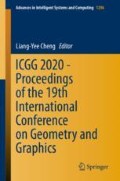Abstract
In this study, the relationship between the works of Vermeer and camera obscura light images and frame composition is considered. It has been suggested that Vermeer may have traced camera obscura images to create his paintings. Although it is unlikely that he could have traced the entire image at once, similar to scanning, it is possible that Vermeer may have taken models, motifs, or relative sizes of different objects from these light images and incorporated them directly into his compositions. One of his works during the early stages of his career is called “Milk Maid.” The results of the analysis of two works from the same period, “Woman in Blue” and “Woman with a Water Jug,” show that multiple horizon lines can be derived, indicating a geometric inaccuracy. This shows that the works of Vermeer were not geometrically accurate during the start of his career. He created stable compositions with geometric accuracy after a certain point in his career. The analysis of “Milk Maid” has created doubts regarding the possibility that Vermeer used a camera obscura to trace the surface of the floor. However, because of factors such as the necessity for focus adjustment and limitations of the light image, he may have faced problems in constructing a geometrically accurate space. This report introduces the personal opinion of the author regarding the boundary lines drawn on floors, which are essential for creating a space with a sense of depth in paintings.
Access this chapter
Tax calculation will be finalised at checkout
Purchases are for personal use only
References
Sato, N.: Camera Obscura’s Role in Johannes Vermeer’s Painting Space. Empirical Studies of the Arts, vol. 28, no. 1, pp. 93–110. Baywood Publishing Company, Inc., Amityville (2010)
Sato, N.: Tiles painted by Vermeer. In: Proceedings of the Fall Annual Conference of the Japan Society for Graphic Science 2019, JSGS, pp. 30–35. (2019). (in Japanese)
Booker, P.J.: A history of engineering drawing, pp. 30–33 (Trans. by, Hara, M.), Shobo, M. (1967) (Original work published 1963). When the distance point was first proven mathematically, the appearance of drafting lines for correctly identifying the horizon line using the distance point were extremely similar to those used with the visual cone section determination method used until that time. For this reason, Booker suggests that medieval painters may have been a bit confused about this property
Ruurs, R.: Saenredam: The Art of Perspective. p. 30, John Benjamins Publishing Company, Amsterdam (1987). According to Ruurs, there was a clear separation between artistic practitioners such as painters and mathematicians in pursuit of hidden line drawing theory in the latter 16th century
Steadman, P.: Vermeer’s Camera: Uncovering the Truth behind the Masterpieces. (Trans. by, Suzuki, K.) Sha, S. (2010). (Original work published 2002)
The shape of the foot warmer can be confirmed in prints from the time, and the top and bottom appear to be nearly square. This kind of shape can be seen in the 1614 print by V. Roemer, “Emblem from Sinnepoppen.”
Steadman, op. cit., p. 55. Based on D. Fink’s experiment. See Note 116
Ibid., 186–187
Ibid., 141
Sato, N.: Pieter de Hooch’s painting space-the interior and perspective drawing. In: Proceedings of the Fall Annual Conference of the Japan Society for Graphic Science 2014, JSGS, pp. 109–114 (2014). (in Japanese)
Hockney, D.: Secret knowledge: rediscovering the lost techniques of the old masters, pp. 60–64. SEIGENSHA Art Publishing (2010). (Original work published 2006). The position of the vanishing point is higher when focusing on the near view of the scene than when focusing on the background
In other works, the position repeatedly partitions the frame into 1/3 or 1/2 divided spaces
Accolti, P.: Lo Inganno De gl’occhi, Prospettiva Pratica, Trattato In Acconcio Della Pittura. Appresso Pietro Cecconcelli, Firenze (1625). THE DIGITAL CICOGNARA LIBRARY, Lo inganno degli occhi. https://cicognara.org/catalog/802. Accessed 15 Nov 2019
Kemp, M.: The Science of Art: Optical Themes in Western Art from Brunelleschi to Seurat, p. 135. Yale University Press, London (1990). From this book, the author could know the existence of Accolti
Andersen, K.: The Geometry of an Art: The History of the Mathematical Theory of Perspective from Alberti to Monge. pp. 377–378, Springer, New York (2007)
Dubreuil, J.: La Perspective Pratique, Necessaire a Tous Peintres, Graveurs, Sculpteurs, Architectes, Orphevres, Brodeurs, Tapissiers, Et Autres Qui Se Meslent de Desseigner. Paris (1642)
Accolti, op. cit., pp. 25–27
Ibid., 26
Sato, N.: Vermeer’s painting space: objects drawn on canvas and perspective. In: Joshibi University of Art and Design Research Report, vol. 45, pp. 17–26 (2015). (in Japanese)
Alpers, S.: The Art of Describing. (Trans. by, Koufuku, A.), pp. 20–21. arinashobo (1993). (Original work published 1984)
Author information
Authors and Affiliations
Corresponding author
Editor information
Editors and Affiliations
Rights and permissions
Copyright information
© 2021 The Author(s), under exclusive license to Springer Nature Switzerland AG
About this paper
Cite this paper
Sato, N. (2021). Vermeer’s Specific Ratio. In: Cheng, LY. (eds) ICGG 2020 - Proceedings of the 19th International Conference on Geometry and Graphics. ICGG 2021. Advances in Intelligent Systems and Computing, vol 1296. Springer, Cham. https://doi.org/10.1007/978-3-030-63403-2_5
Download citation
DOI: https://doi.org/10.1007/978-3-030-63403-2_5
Published:
Publisher Name: Springer, Cham
Print ISBN: 978-3-030-63402-5
Online ISBN: 978-3-030-63403-2
eBook Packages: EngineeringEngineering (R0)

